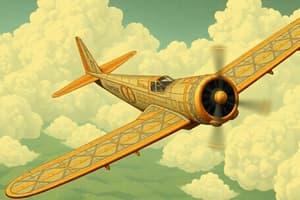Podcast
Questions and Answers
What is the purpose of the dual control system in the aircraft?
What is the purpose of the dual control system in the aircraft?
- To reduce weight in the cockpit
- To enhance communication between pilots
- To allow either pilot to control the ailerons, rudder, and elevators (correct)
- To enable autopilot functionality
How are the wing flaps positioned in the aircraft?
How are the wing flaps positioned in the aircraft?
- Manually by the pilot only
- By altering the aileron settings
- Using a hydraulically actuated system controlled by a single lever (correct)
- Automatically based on flight speed
What ensures the security of attachments in the flight control system?
What ensures the security of attachments in the flight control system?
- Electronic monitoring systems
- Use of lightweight materials
- Proper alignment of control cables and structural routing (correct)
- Daily maintenance checks
What is the function of the dual indicating tab position indicator?
What is the function of the dual indicating tab position indicator?
Why are the primary control surfaces balanced?
Why are the primary control surfaces balanced?
What action should be taken if components of the flight control system are not properly placed?
What action should be taken if components of the flight control system are not properly placed?
What is the role of sealed bearings in the flight control system?
What is the role of sealed bearings in the flight control system?
What should be recorded during maintenance of the flight control system?
What should be recorded during maintenance of the flight control system?
Study Notes
General Description of Flight Controls
- Aircraft features all-metal flight control surfaces: ailerons, rudder, elevators, and wing flaps.
- Dual controls for primary surfaces: ailerons, rudder, and elevators for pilot and co-pilot.
- Wing flaps controlled by a single lever, easily accessible to both pilots, using hydraulic actuation.
- Movable trim tabs on rudder and elevators controlled by overhead trim tab control panel.
- Dual indicating tab position indicator displays rudder and elevator trim tab positions on the right instrument panel.
- Fixed, ground adjustable trim tab located on the right aileron enhances control.
- Control column, control wheel, and rudder pedals use a mechanical interconnection system including push-pull rods, bellcranks, and cables.
- All primary control surfaces are balanced to enhance control stability and prevent flutter across various flight speeds.
- Sealed bearings decrease friction and wear across the flight control system.
- Control cable pulley brackets equipped with guard pins to maintain cable alignment and prevent skipping.
Maintenance of Flight Controls
- Control cables removal and installation require careful alignment with the structural routes.
- Control surface balancing ensures optimal performance; includes general balance procedures and specific instructions for adjustment.
Flight Control System
- Controls include columns for aileron, rudder, elevator, and wing flap operations.
- Wing flaps contribute to lift enhancement, aiding in shorter takeoff distances and lower landing speeds.
- Continuous inspection and maintenance are critical for functionality and safety.
- Special attention needed for security of attachments and usage of correct control cables.
- Functional checks required for access cover parts to ensure comprehensive maintenance.
- Rerigging may be necessary if control components are misaligned.
- Adjustments to control systems should be minimal and documented, particularly for repairs or replacements.
Studying That Suits You
Use AI to generate personalized quizzes and flashcards to suit your learning preferences.
Description
This quiz focuses on the all-metal flight control surfaces of aircraft, including ailerons, rudder, elevators, and wing flaps. It covers the mechanics of dual controls, hydraulic actuation, and trim tab operation, providing an insightful exploration of aircraft functionality.




